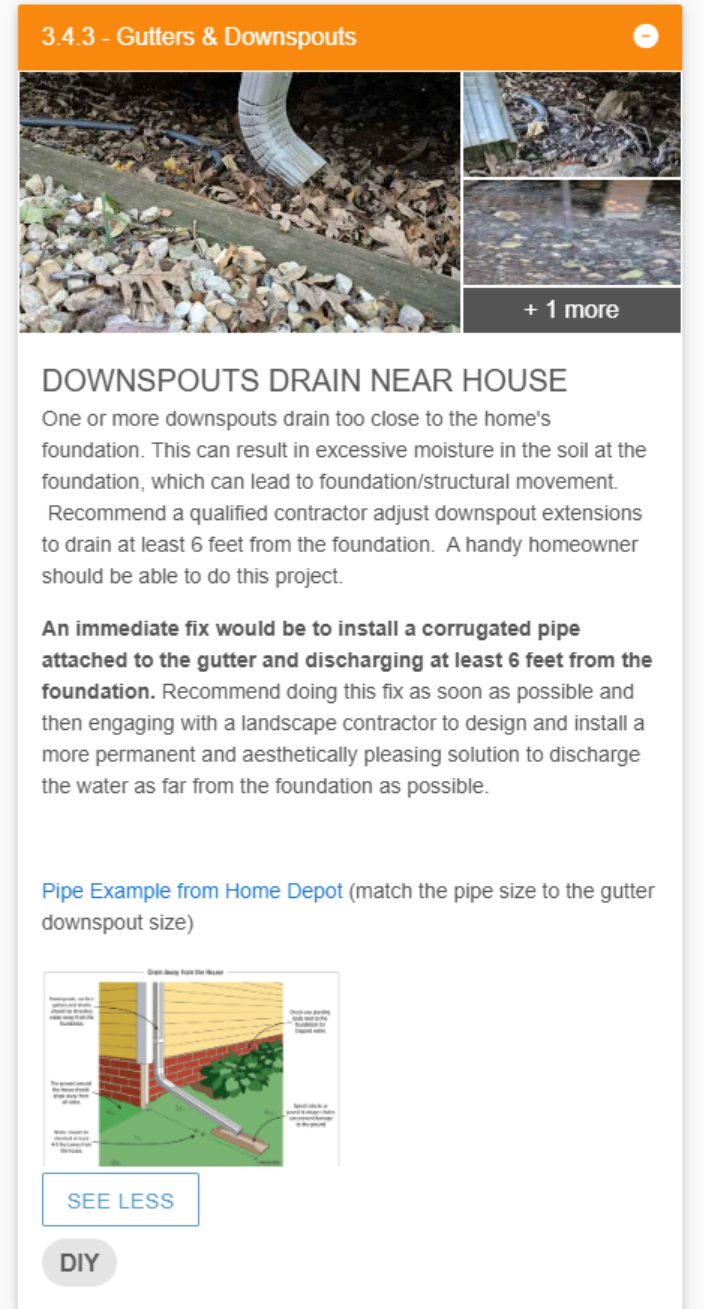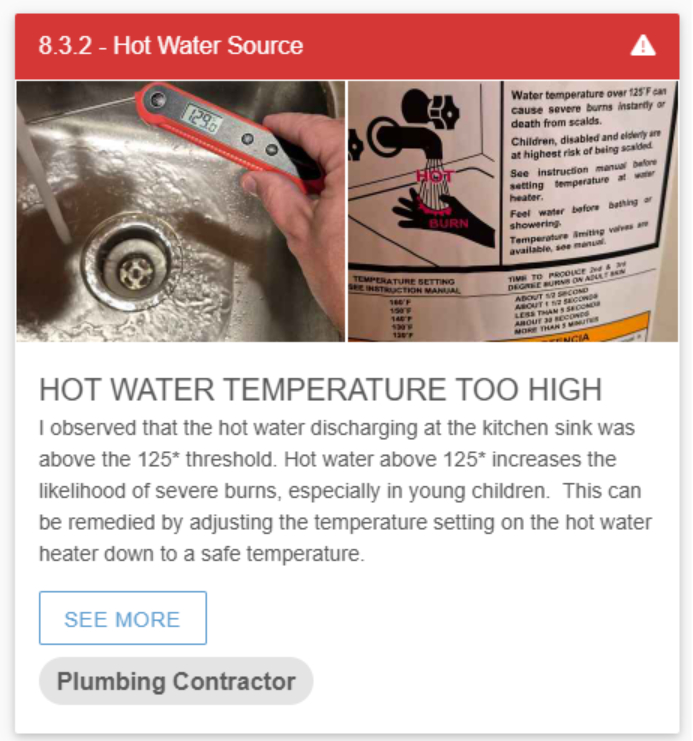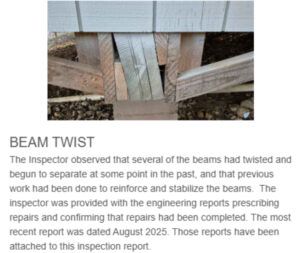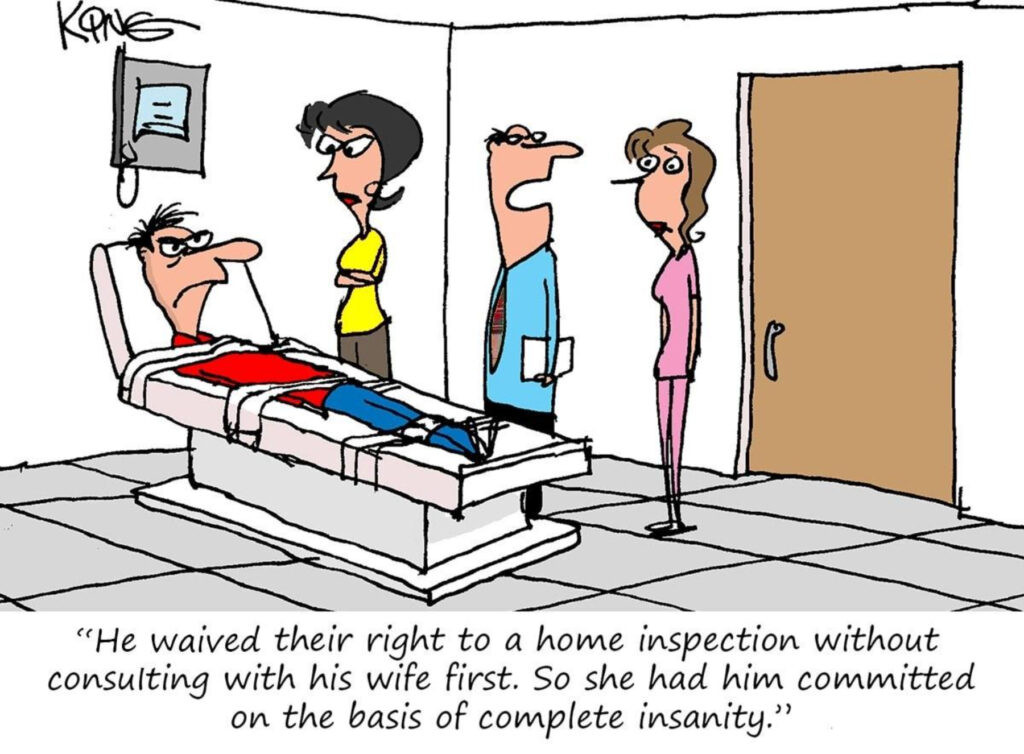How to Prioritize, Plan For, and Address Defects Found in Your Home Inspection Report
If you’ve read any of our other posts, this next sentence will be familiar to you. When you first see the list of defects in your inspection report, the first thing to do is take a deep breath and understand that context is everything and everything CAN be fixed. Not all defects are created equally and understanding the context and importance of each defect is important. Understanding the context of the defects will enable you to make a plan on addressing them. This article will provide guidance on how to prioritize defects identified on your home inspection report. Oh, and congratulations on finding a home, we hope this helps you make informed decisions!
Step 1: Understand Your Inspection Report
- For more detailed guidance on how to read the inspection report itself, we recommend reading this article series.
- The inspection report contains a lot of information, it categorizes defects based on type and then provides context in the form of a written narrative with supporting pictures, videos and diagrams to explain, why it was flagged as a problem or potential problem.
- Read the inspection report, then read it again a day later and call your inspector if you have any questions. Here at Tech Inspect Home Services, we are more than happy to answer any follow-on questions for our clients. Email us if you need to, we answer those too!
- If Tech Inspect did your inspection, we include a lot of links to DIY articles, diagrams, context and links to hardware from Home Depot and Lowes to show what we’re talking about and to give you a better understanding of the prices involved.
Here is an example of a Defect Card with a proposed solution, link to materials and a diagram to illustrate what it should look like:

Step 2: Sort Findings into Priority Levels
Safety & Structural: Must-Address Immediately
- Electrical hazards, gas leaks, and foundation issues are top-priority items.
- Anything that poses a safety hazard should be addressed first.
- It’s important to note that just because it’s a safety hazard doesn’t mean it’s going to be costly to fix. Some safety hazards are straightforward and relatively inexpensive to remediate; others will require professional support. Context is everything.
An example of a safety hazard that’s inexpensive to fix — and could be handled as a DIY project or by a plumber — is adjusting the temperature on a hot water heater. This can be accomplished simply by changing the setting on the water heater.

- Any Structural Issues should be addressed right away too and carry equal importance as safety specific issues.
- For Example, if we found a broken truss member, getting a General Contractor to fix it, should be high on the priority list, as this weakens the roof support system. Don’t find out the roof can’t’ handle the weight with the next big snowstorm… Plan to get these fixed poste haste and consider the time of year.
- If we recommend a structural engineer, getting them out to investigate immediately should be a top priority item. A structural engineer will fully assess the condition and may be able to provide prescribed solutions to resolve the problem.
Structural example, the beams on this structure had previously twisted and rotated. An engineer prescribed a fix, a contractor installed the fix, and the engineer confirmed the fix was done properly. This was done before the inspection, but if was un-resolved then this would be a primary concern for a new homeowner, and they would need to move quickly to address this and understand what it would take to fix it.

Water Intrusion (from the outside-in) and inside leaks
- Any signs of active water leaks or defective water management systems should be addressed immediately. An active water leak could lead to mold growth, deterioration of building materials and can quickly get out of hand, if left unchecked.
- The homeowner should remember that, if we found an active water leak during an inspection, the inspector doesn’t know when that leak started. It may have just started, or it may have been leaking for a year. The inspector has no way of knowing, so the best course of action is to resolve it, immediately.
- What is a water management system? This includes flashing, gutters and site drainage and more. (see the previous graphic of an actual inspection report)
- A good example is, if the gutters are discharging at the foundation instead of many feet away, this can be immediately corrected, day one of ownership by installing some cheap (<$10) drain extensions. This can serve as a temporary (yet effective) solution, until a more complete, permanent and more aesthetically pleasing solution can be installed. This can help prevent new problems or keep them from making existing problems worse.
Functionality & Systems: Plan in the Near Term
- HVAC nearing end of life, roof wear or other mechanical systems that be aged or end of life.
- HVAC systems that are aged and nearing end of life should be planned for replacement in the near term. No-one can predict exactly when it will fail, but suffice to say, murphy is rude, and you can expect it to fail when it’s least convenient (like the hottest week of the year). Planning and being proactive with these repairs will go a long way.
- If we were unable to test the AC unit due to weather conditions, we recommend having an HVAC professional look at it, as soon as possible under the right weather conditions to ensure proper functioning, and if it’s not functioning, add it to the list.
- HVAC systems that are aged and nearing end of life should be planned for replacement in the near term. No-one can predict exactly when it will fail, but suffice to say, murphy is rude, and you can expect it to fail when it’s least convenient (like the hottest week of the year). Planning and being proactive with these repairs will go a long way.
Cosmetic & Maintenance: Monitor or DIY Later
- Cracked trim, worn finishes
- While damaged trim or worn finishes on the stairs, may look bad, they don’t necessarily affect the functionality of the home. These can be taken care of in due time but aren’t as important as a functioning heater in the winter. Would you rather have stains on the carpet or frozen pipes in the winter?
Step 3: Get Qualified Quotes for True Cost of Ownership
Why do cost estimates matter more than the defect itself?
Defects in a home (or vehicle) are just symptoms, they tell you what’s wrong, but not what it will cost to fix it. Cost estimates translate the defect into dollars, factoring in labor, materials, contingencies, and scope uncertainty, especially with unseen issues that often arise once work begins. Estimates enable budgeting, informed decision-making, risk management, adding additional context to your defect. A clear estimate can be a clear differentiator on the importance and impact of a defect. What may seem to be a relatively benign defect may have much more bearing if the cost to fix is exceedingly high.
A 2020 Study from RepairPricer.com, found more than 1 million repairs were needed across 50,000 homes, while the average home required more than $11,000 in repairs.
- The five most expensive home defects—ranging from slightly more than $1,000 to just less than $10,000 in repair cost—were identified in 9 to 20 percent of homes studied.
Discuss a strategy with your rea estate agent, they can help advise you on timetable, room for extension, negotiation, and what to prioritize. Take the feedback and concerns from the inspection report and the feedback from your realtor together to guide you in this next process.
If the next steps are to get some estimates, you will need to be aggressive with getting qualified professionals to the home. Remember, they may not be able to come out the same day you call, so plan accordingly.
Tech Inspect Home Inspection reports provide a list of local contractors in each inspection report based on the defects and recommendations in the report. This is a good starting place if you don’t already have an existing relationship with local contractors.
Step 4: Decide: Negotiate with the Seller or Budget for Repairs
When to Request Repairs vs Credit
Option 1: Asking the Seller to Complete Repairs
Pros:
- Repairs are done before you move in, one less headache. Seller handles scheduling, permits, and labor, freeing you from the hassle.
- Ideal for urgent and safety-critical defects, especially if the seller has access to contractors and can act quickly.
- Tech Inspect Inspector can come back and verify the completion of the repairs and update the inspection report.
Cons:
- You lose control over how, or how well, the work gets done. Sellers may hire the cheapest contractor, cut corners, or rush through the fixes.
- Repairs can delay closing, or even fall apart at the last minute, leading to frustration and complications.
- Once completed, it’s tough to prove shoddy work afterward. You may inherit problems with no recourse.
- Tech Inspect charges a Re-Inspection Fee to Re-Inspect a home (see Inspection Agreement for details)
Option 2: Asking for a Repair Credit or Price Adjustment
Pros:
- You control who does the work, when, and how, so you get the quality you demand and can prioritize at your own pace.
- Often accelerates closing. No repair, scheduling delays or disputes over workmanship.
- A credit reduces the total home cost (or your closing costs), which also decreases your mortgage amount.
- If repairs are done and submitted within the Term limits, the InterNACHI Warranty Program that Tech Inspect Home Services Participates in will help offset some of those costs.
Cons:
- You must pay for the repairs yourself, possibly out-of-pocket upfront, on top of down payment and closing costs.
- Credit may not fully cover costs, especially if issues worsen or additional problems surface.
Average Price Concessions Buyers Get After Inspection
- We recommend discussing this with your realtor, this can vary by market, and they’ll have the most up-to-date information and real-world experiences.
When a Seller Can Refuse—and What to Do
- The contract is “as-is.” Missouri’s standard “AS IS Residential Contract” makes it clear that the seller won’t do repairs, but they must still disclose known material defects. “As-is” removes repair obligations but doesn’t waive truthfully disclosing issues.
- Seller fulfills disclosure requirements. Missouri law doesn’t force repairs, but sellers must complete a Seller’s Disclosure Statement listing known defects—like structural problems, water damage, hazardous materials, proximity to landfills, meth-lab history, or lead paint, where applicable. Concealing such defects could lead to contract cancellation or legal consequences.
- There’s no inspection contingency or it’s expired. Unless the offer includes a valid inspection contingency, a seller has no obligation to negotiate post-inspection. If that timeline lapses, the seller can reject all requests without penalty
- Discuss with your Realtor before the Inspection, It’s best to understand what the options are even before you get the report.
Step 5: Prioritize Repairs in Your Ownership Timeline
- Prioritize the repairs, based on the need and potential life span left of the components.
- Use a home maintenance schedule, plan for seasonal maintenance and repairs.
- Consider the Time of Year that you are moving in.
- For example, if you purchase in May and there’s an issue with the heater, you can wait a few months to get that fixed, but DON’T forget about it. Plan accordingly based on the weather and time of year.
- Repair timelines can vary, based on the defect, the budget, time needed to fix it and the environment.
Step 6: Protect Yourself with Follow-Up Inspections
- Sewer scopes, structural engineer reports, pest inspections
- Schedule an annual maintenance inspection to keep up with any changes to your home.
Step 7: Avoid Surprise Costs — Budget & Emergency Fund Tips
- Build buffer into closing costs, don’t assume that you’ll be able to negotiate credits or $ off the purchase price. Ensure you’re leaving enough money in the budget to cover any major home repairs after your inspection. Tech Inspect Home Services participates in a short term warranty program to help with any surprise costs up to 90 days after closing or 120 days after your inspection (T&C’s apply). This program is provided free of charge to Tech Inspect clients and can help offset surprise repairs.
- Emergency Fund Tips: Set aside $3-5 thousand just for home repairs and keep that fund replenished as you use it. This will cover the majority of minor to medium repairs costs and keep it from becoming a burden.
Summary: Making Smart Choices with Inspection Findings
Remember, everything can be fixed. We know that, it may seem overwhelming when you first get the inspection report but taking a minute to really consider what’s important and prioritize the things identified in the report and planning will help put everything in focus. The inspection report should serve as a trigger for starting additional work by you. Work that needs to be completed quickly due to the ticking clock. Remember, this is your opportunity to save money and ensure your home is in tip top shape for years to come!
Planning is critical after your inspection, remember, you’re on a timeline. Have a discussion with your realtor, identify the key items that need further investigation and then reference the contractor list we provide in every inspection report to get additional information and help from the contractors.
You’ll need to be aggressive with getting quotes so that you can get all the information you need to make decisions or negotiate. Knowledge is power, and the more information you can gather, the more knowledge you can obtain.
Finally, congratulations on your new home!
FAQ
- What should I fix first after a home inspection? Safety, Structural and water management issues or leaks.
- Can a seller refuse to fix anything after inspection? Yes, it depends on the sale type and other factors, it’s best to discuss this with your realtor.
- What are the most expensive things to repair after a home inspection? Roof, Structural and HVAC systems are the most expensive items to repair.
- Do you provide contractor recommendations? Yes, in every inspection report, we provide a list of contractor recommendations. For example, if we find an HVAC issue with your heating or cooling systems, we’ll recommend a local service company such as Level 9 Heating cooling and Plumbing based in Washington, Mo, who serves St. Charles County as well.
- What happens if I ignore inspection defects? They can continue to worsen or cause additional/new issues with the home, having a negative effect on the home’s usability and value.
- Should I still buy a house with a bad inspection report? It depends. Everything can be fixed, but It depends on your budget, timeline and what you are willing to accept or do. Consulting with your home inspector, realtor and getting accurate quotes from contractors will help clarify your next steps. For more information on this concept check out this article.
If you’re buying a home, DON’T skip the home inspection. If you DID skip the inspection, it’s never too late to get the home inspected. Remember, your home inspector is here to support you.

